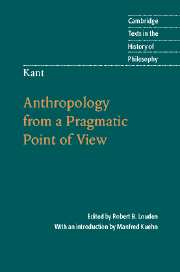Book contents
- Frontmatter
- Contents
- Introduction
- Chronology
- Further reading
- Note on the text and translation
- Anthropology from a Pragmatic Point of View
- Preface
- Contents
- Part I Anthropological Didactic. On the way of cognizing the interior as well as the exterior of the human being
- Book I On the cognitive faculty
- Book II The feeling of pleasure and displeasure
- Book III On the faculty of desire
- Part II Anthropological Characteristic. On the way of cognizing the interior of the human being from the exterior
- Index
- Cambridge Texts in the History of Philosophy
Book II - The feeling of pleasure and displeasure
Published online by Cambridge University Press: 05 June 2012
- Frontmatter
- Contents
- Introduction
- Chronology
- Further reading
- Note on the text and translation
- Anthropology from a Pragmatic Point of View
- Preface
- Contents
- Part I Anthropological Didactic. On the way of cognizing the interior as well as the exterior of the human being
- Book I On the cognitive faculty
- Book II The feeling of pleasure and displeasure
- Book III On the faculty of desire
- Part II Anthropological Characteristic. On the way of cognizing the interior of the human being from the exterior
- Index
- Cambridge Texts in the History of Philosophy
Summary
Division
1) Sensuous pleasure, 2) intellectual pleasure. The former is either introduced A) through sense (enjoyment), or B) through the power of imagination (taste); the second (that is, intellectual pleasure) is either introduced a) through representable concepts or b) through ideas, – – and thus the opposite, displeasure, is also introduced in the same way.
On sensuous pleasure
On the feeling for the agreeable, or sensuous pleasure in the sensation of an object
Enjoyment is a pleasure through sense, and what amuses sense is called agreeable. Pain is displeasure through sense, and whatever produces it is disagreeable. – They are opposed to each other not as profit and lack of profit (+ and 0), but as profit and loss (+ and −), that is, one is opposed to the other not merely as opposite (contradictorie s. logice oppositum), but also as counterpart (contrarie s. realiter oppositum). – – The expressions for what pleases or displeases, and for what is in between, the indifferent, are too broad; for they can also refer to intellectual pleasure and displeasure, where they would then not coincide with enjoyment and pain.
One can also explain these feelings by means of the effect that the sensation produces on our state of mind. What directly (through sense) urges me to leave my state (to go out of it) is disagreeable to me – it causes me pain; just as what drives me to maintain my state (to remain in it) is agreeable to me, I enjoy it.
- Type
- Chapter
- Information
- Kant: Anthropology from a Pragmatic Point of View , pp. 125 - 148Publisher: Cambridge University PressPrint publication year: 2006



